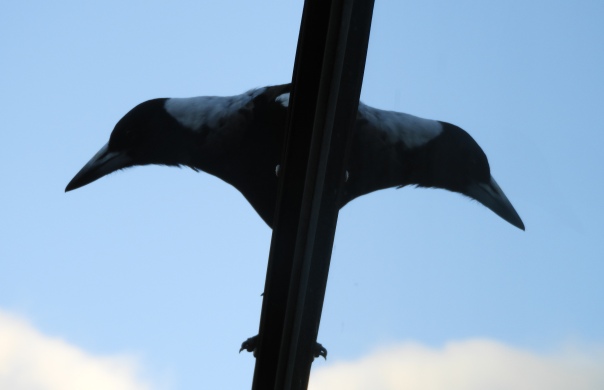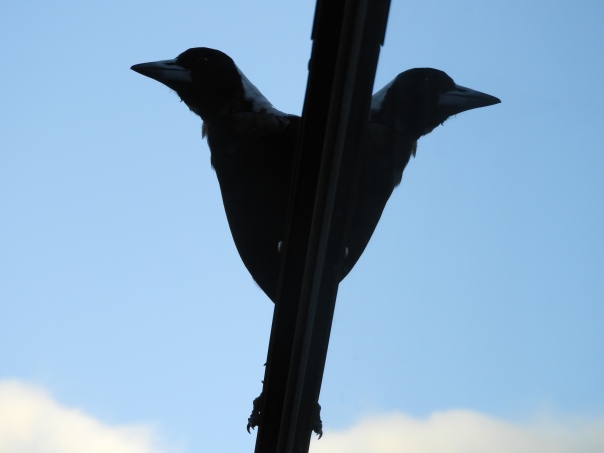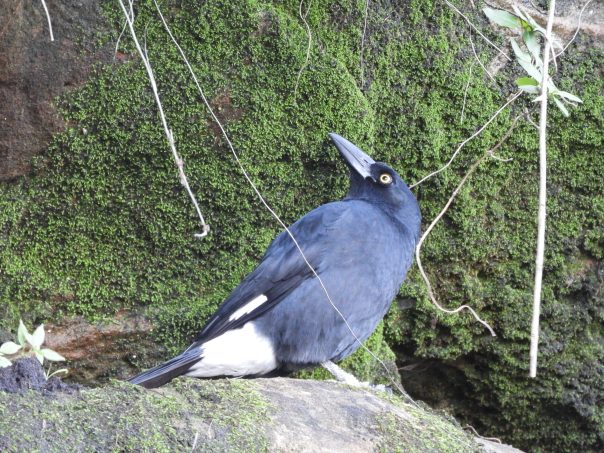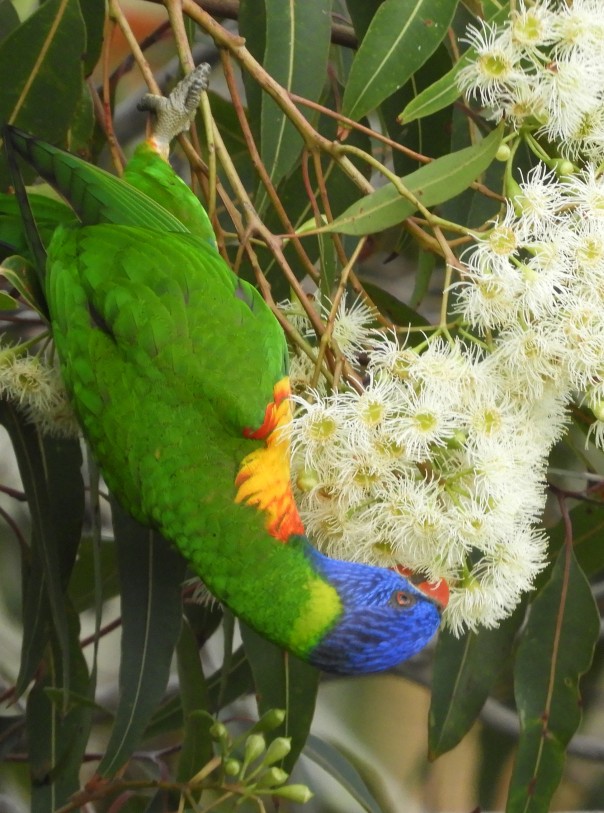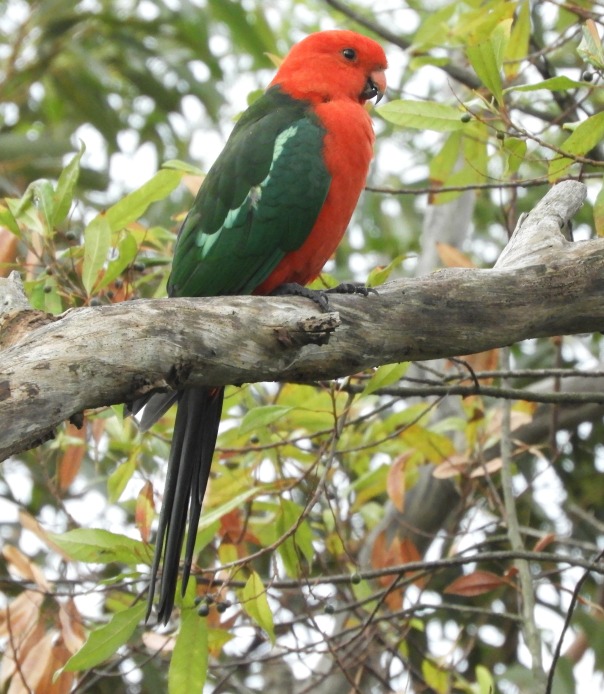Category Archives: Currawong
Currawong crazy hour
An excited group of currawongs made our backyard the centre of their activity yesterday afternoon. The commotion lasted at least half an hour. Birds dashed back and forth, calling and flying noisily past each other. Parents of young children will sympathise with the term “crazy hour”, sometimes called the “witching hour”, in late afternoon — it seems to apply to currawongs too!
Common name: Pied Currawong
Scientific name: Strepera graculina
Approximate length: 45 cm
Date spotted: 31 August 2024 (end of winter)
Location: Allambie Heights, north of Sydney, New South Wales, Australia
Currawong youngsters with Avian Pox (plus a bonus cicada story)
A couple of young Pied Currawongs have been making quite a racket in our neighbourhood recently. I was puzzled and concerned when I noticed that one of them had red swellings around its eyes and an unhealthy-looking bump on top of its beak.

Aside from being unsightly, though, the swellings don’t seem to bother the youngster much. For wont of a better name, let’s call this one Youngster 1. The bird is quite lively and curious, and feeding well.
Here’s Youngster 1 hiding in the shade, awaiting its next feed:
The other young Currawong, Youngster 2, now also has similar swellings, though to a lesser extent:
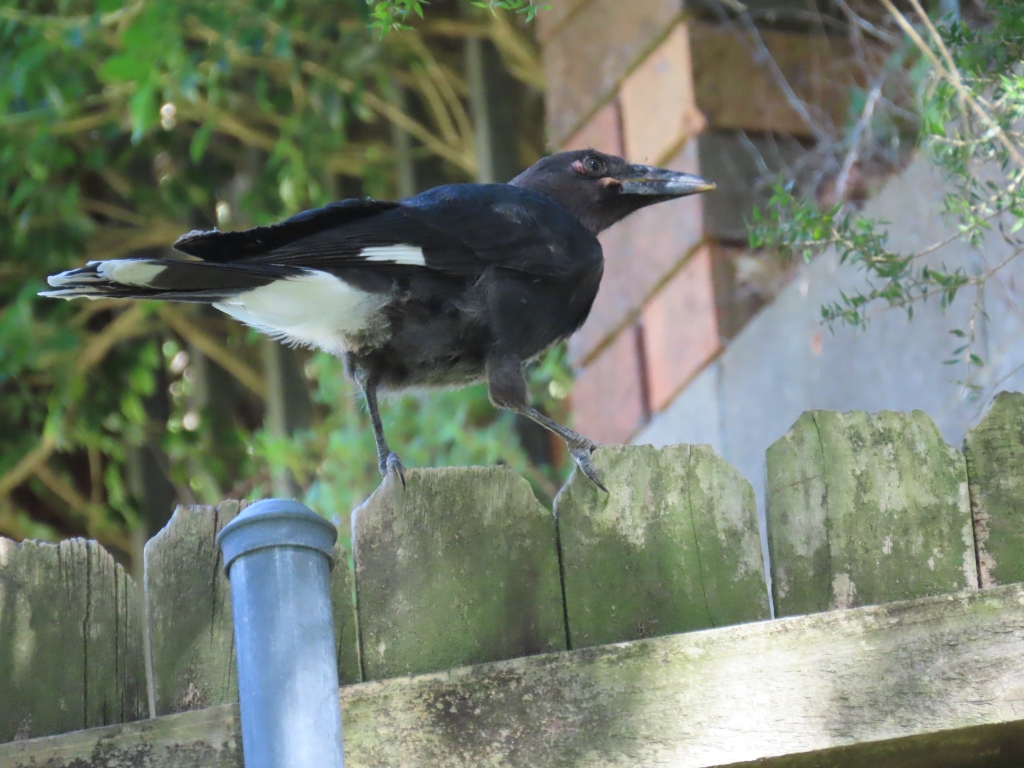
Here’s Youngster 2 sitting on the same fence as its sibling:
After some research and image comparison, I’ve discovered that these two little ones are most likely suffering from Avian Pox. This condition is caused by a virus that infects many bird species around the world, including currawongs and other Australian birds. It’s usually not too serious, and the birds recover within three to four weeks.
That’s good to know!
Here’s a glimpse of one of the hard-working adult currawongs, taking a breather between feeding runs:

Common name: Pied Currawong
Scientific name: Strepera graculina
Approximate length: 45 cm
Date spotted: 19 January 2024 (summer)
Location: Allambie Heights, north of Sydney, New South Wales, Australia
A bonus cicada story
A couple of weeks ago, I was filming one of the baby currawongs being fed:
As I was filming a bit of drama occurred. Alas, I didn’t capture any of it on film, as the action took up the whole sky and went down very fast.
Picture this:
A cicada flies past. Two little Noisy Miners give chase. One of them grabs the cicada and lands on our roof, the other Noisy Miner in close pursuit. A currawong parent thinks, “Ah, perfect for the little one.” It swoops on the Noisy Miners, who both fly away, abandoning the cicada to buzz around on the roof. The currawong grabs the cicada.
Not taking this lightly, the Noisy Miners swoop on the baby currawong, which is minding its own business deep in the foliage. There’s a sudden flurry of activity as the adult currawongs and Noisy Miners swoop noisily around the tree. The baby takes deeper cover under a thick leafy branch. The fuss dies down and everyone goes about their business.
I don’t know what happened to the cicada.
Post-fire scenes from the Australian bush
The National Parks and Wildlife Service recently conducted a hazard reduction burn in one of my favourite bush-walking areas. The NPWS lights these controlled fires to burn away excess vegetation, which reduces the chance of a more severe fire raging out of control during fire season.
Many of the plants in the Australian bush are adapted to cope with fires. For example, these Hakea seedpods popped open after the fire, allowing the seeds to escape:
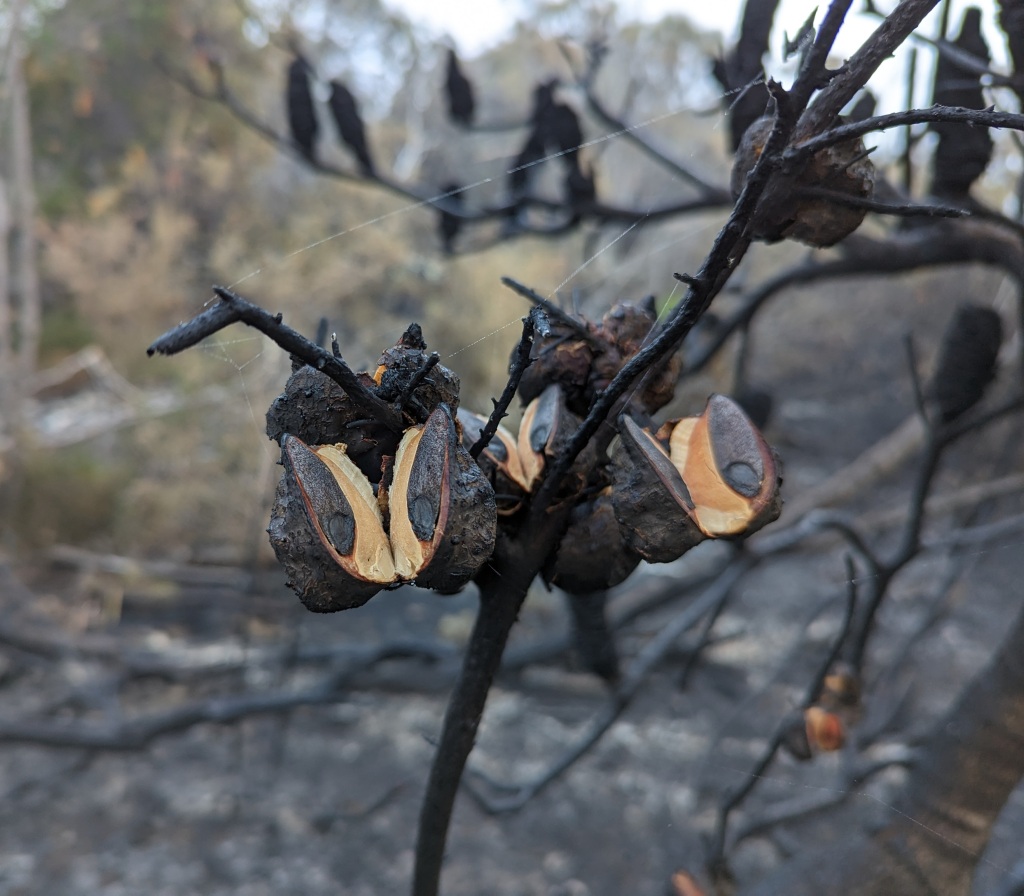
The above seed pods have both seeds still in place — the seeds are black and oval-shaped. Each seed is attached to a thin membrane, which acts as a wing: when the seed is released, it spirals gently to the ground. If there’s any wind around, the seed can travel a short distance from its parent bush.
In the next photo, only one of the seeds remains in the pod:

The next photo shows the seed head of a Banksia bush, also popped open to release the seeds. The open pods look like smiling mouths:

An Australian Brush-turkey wanders over the ashes, looking for pickings. A discarded can echoes the bird’s colouring:
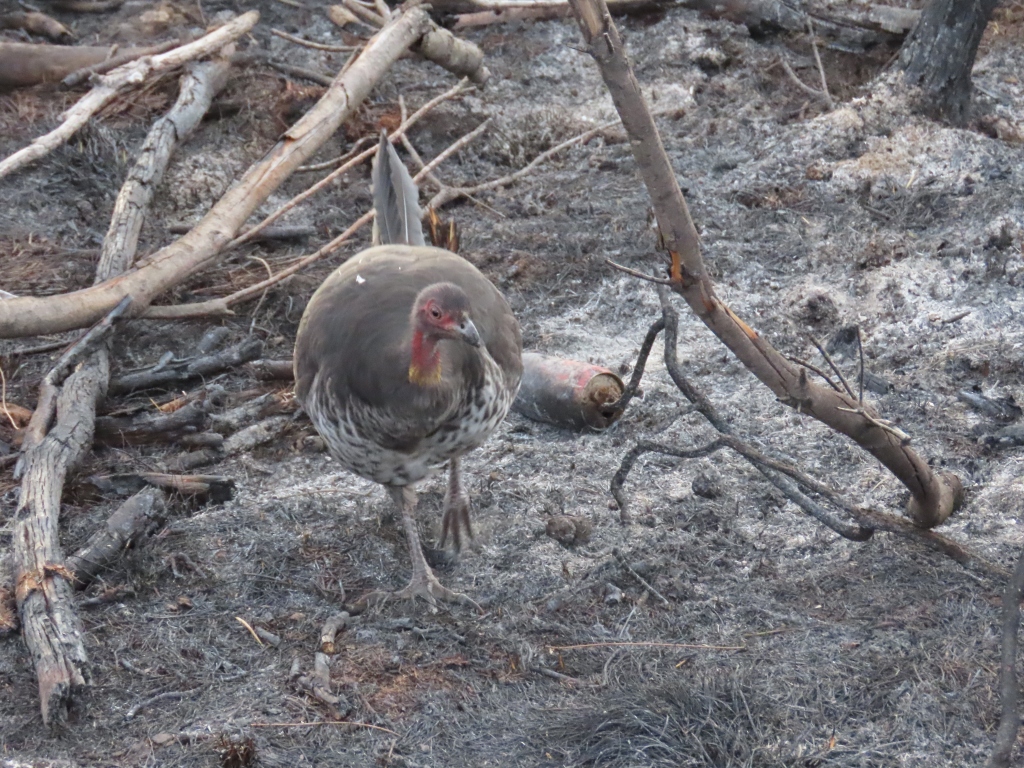
Nearby, Australian Ravens look for insects and other goodies:

A Currawong keeps a watchful eye over the proceedings:

A Rainbow Lorikeet adds a splash of colour, hoping to snag a Casuarina seed or two:
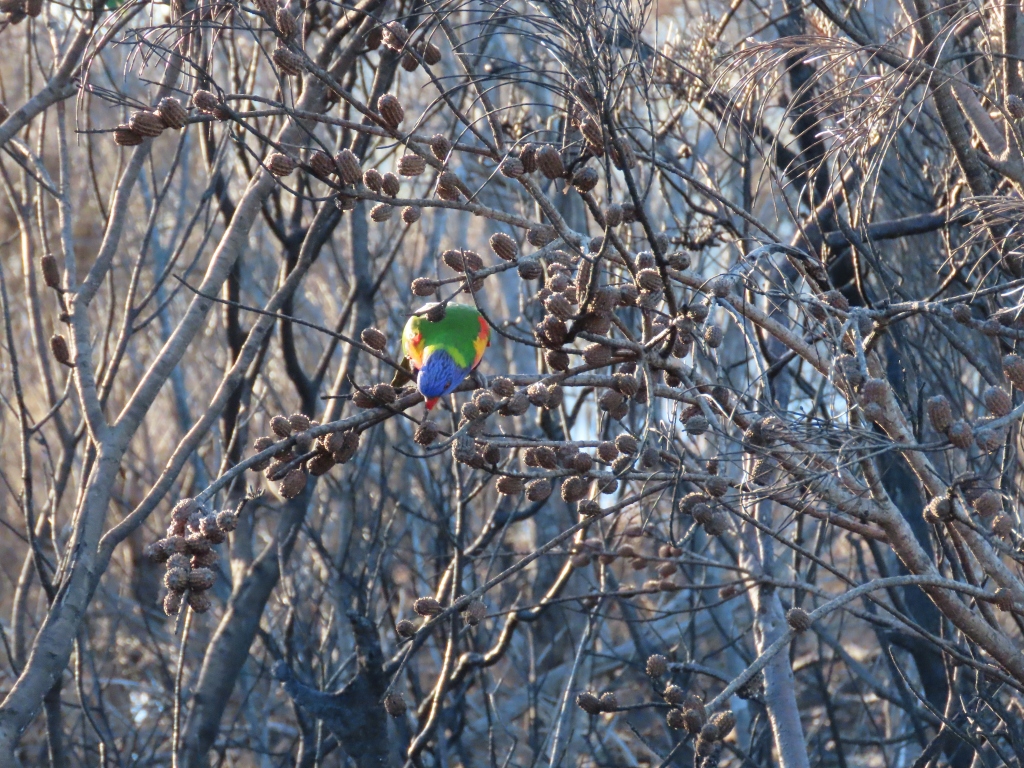
It’s much easier to grab a seed now that the fire has dried out the seedpods!
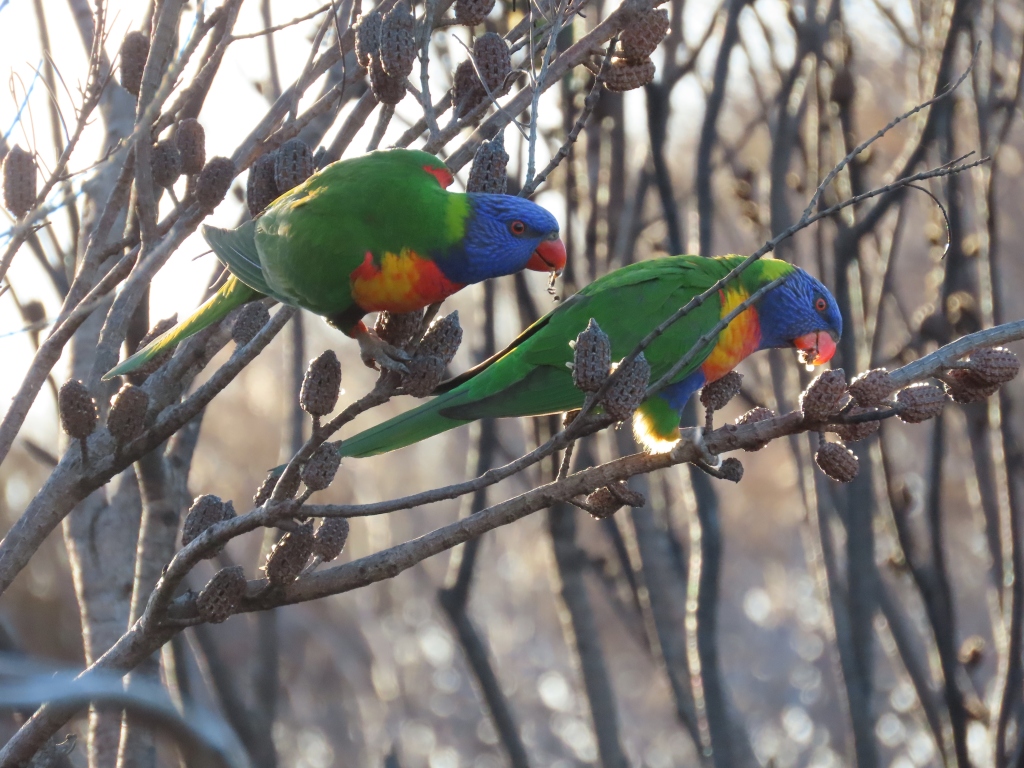
A week later, a Swamp Wallaby shared the browns and greys of the burned area too:
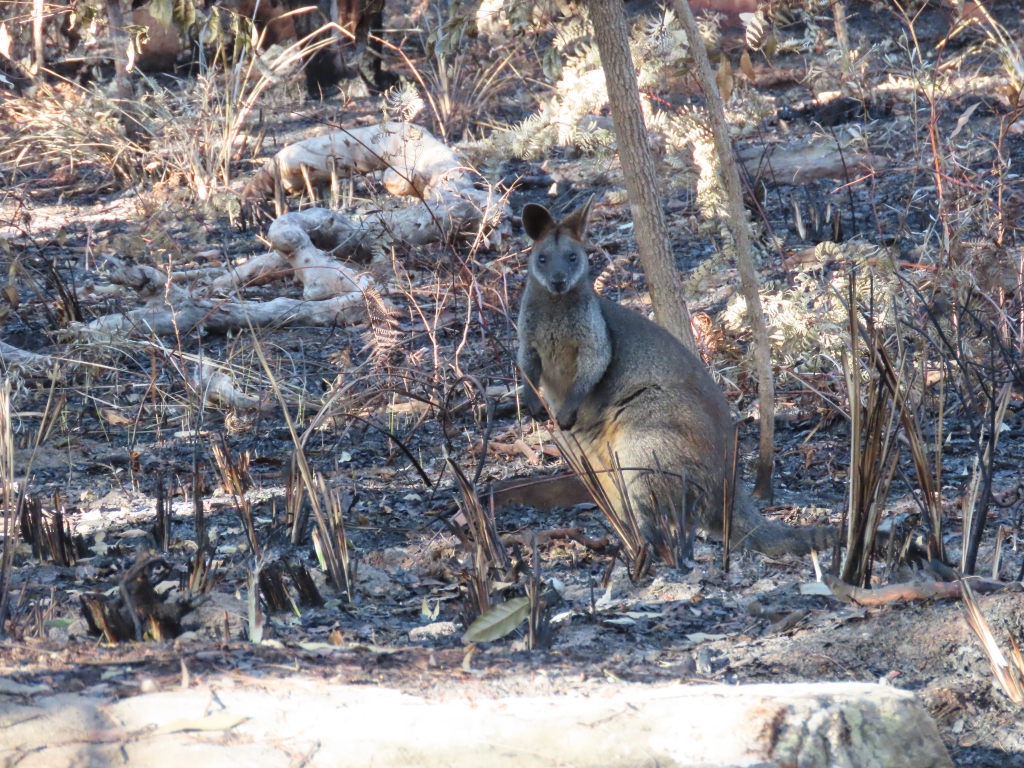
Here’s a video of the wallaby. At one stage, a plane flies overhead and a group of birds squawk loudly. The wallaby looks at me, checking whether I’m the cause of the disturbance, then goes calmly about its business:
To close, here’s a restful scene of the post-fire forest in the early morning light:

Date spotted: Early June, 2023
Location: Dobroyd Head, Sydney Harbour, NSW, Australia; between this point and this point on the map.
Young Channel-billed Cuckoos fed by currawongs
What’s that caterwauling? It’s a couple of young Channel-billed Cuckoos, awaiting their food. Are the patient bringers of food the parents of the young birds? No, they’re Pied Currawongs. Because, like other parasitic cuckoos, Channel-billed Cuckoos lay their eggs in the nests of other birds and leave it entirely to the adoptive parents to care for the youngsters.
The other ongoing noise that you hear in this video are the Cicadas. It’s the season of noisy beetles and noisy birds!
This is the second time that I’ve seen two young cuckoos being fed by currawongs, instead of just one. Evidently it’s quite common for these birds to lay more than one egg in someone else’s nest.
Here’s a still photo of the young cuckoo. What a big baby. It’s far larger than the currawongs that are taking care of it.

Here’s the youngster flapping its wings to make sure its carers don’t miss it:
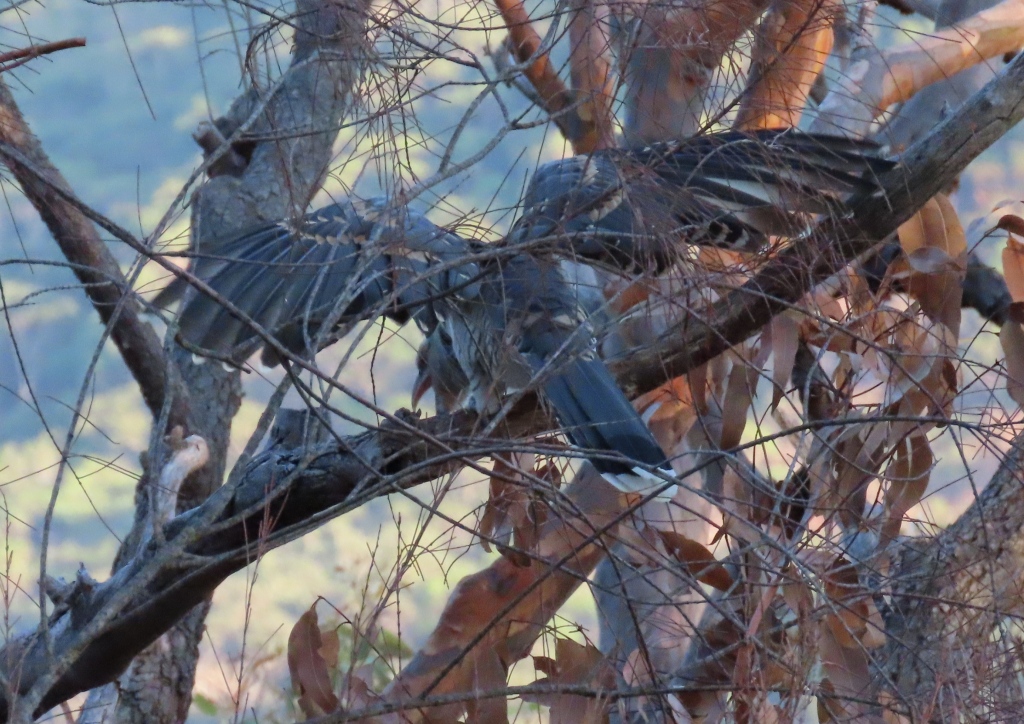
Channel-billed Cuckoo | Scythrops novaehollandiae | Approximate length: 58-65 cm
Pied Currawong | Strepera graculina | Approximate length: 45 cm
Date spotted: 28 December 2022 (summer)
Location: Manly Dam Park, New South Wales, Australia: 33°46’50.1″S 151°14’59.6″E
The gorgeous song of the Currawong
A couple of months ago, I heard these Currawongs exchanging snippets of song. It amazes me how varied the calls of these birds are, and how beautiful:
Common name: Pied Currawong
Scientific name: Strepera graculina
Approximate length: 45 cm
Date spotted: 15 October 2022 (spring)
In the video, the birds are just a silhouette. Here’s a photo of a Currawong from an earlier post:
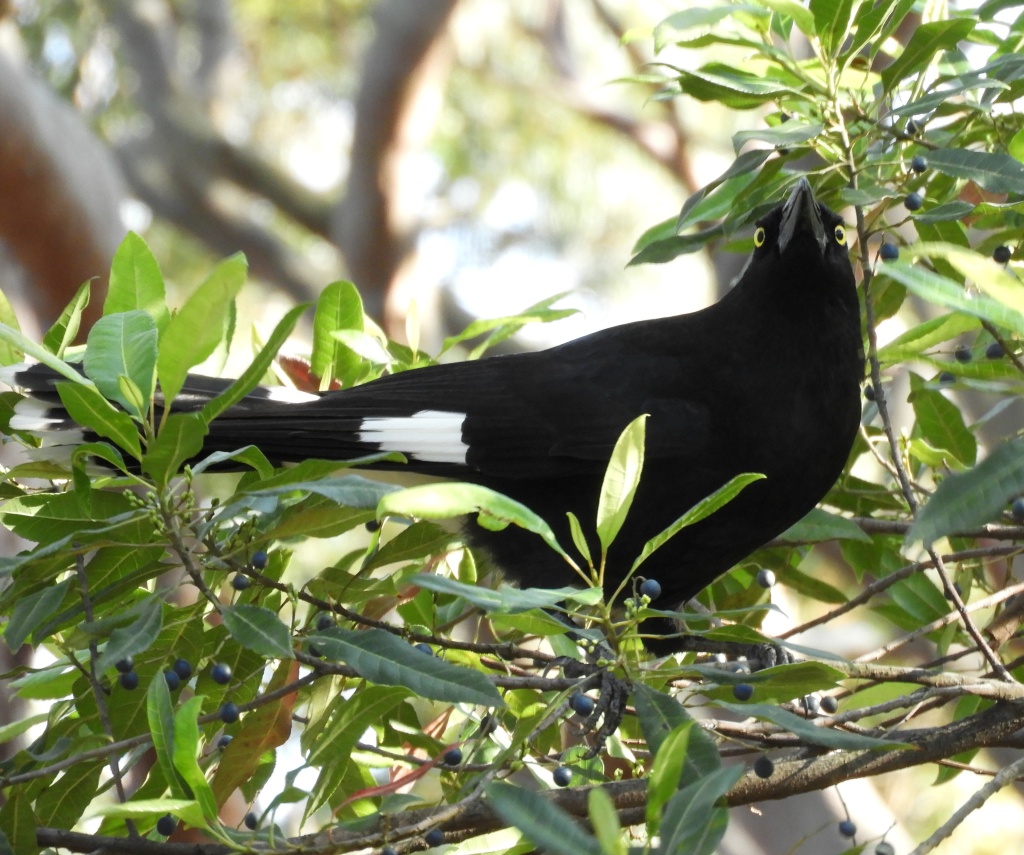
If you’d like to hear more of the Currawongs’ songs, take a look at my earlier post, where the birds are excited about the fruiting Blueberry Ash trees.
Channel-billed Cuckoo laying egg in Currawong nest
This little episode happened in my garden today. It was interesting and exciting to watch!
A cacophany of Noisy Miners and Currawongs drew me out into the garden to see what was up. High in a gum tree were two Channel-billed Cuckoos, being harassed as usual by the other birds. I only managed to get one of the cuckoos into my camera sights. Luckily, it turned out to be the female bird.
Here’s the Channel-billed Cuckoo on the right, with a little Noisy Miner by its side:
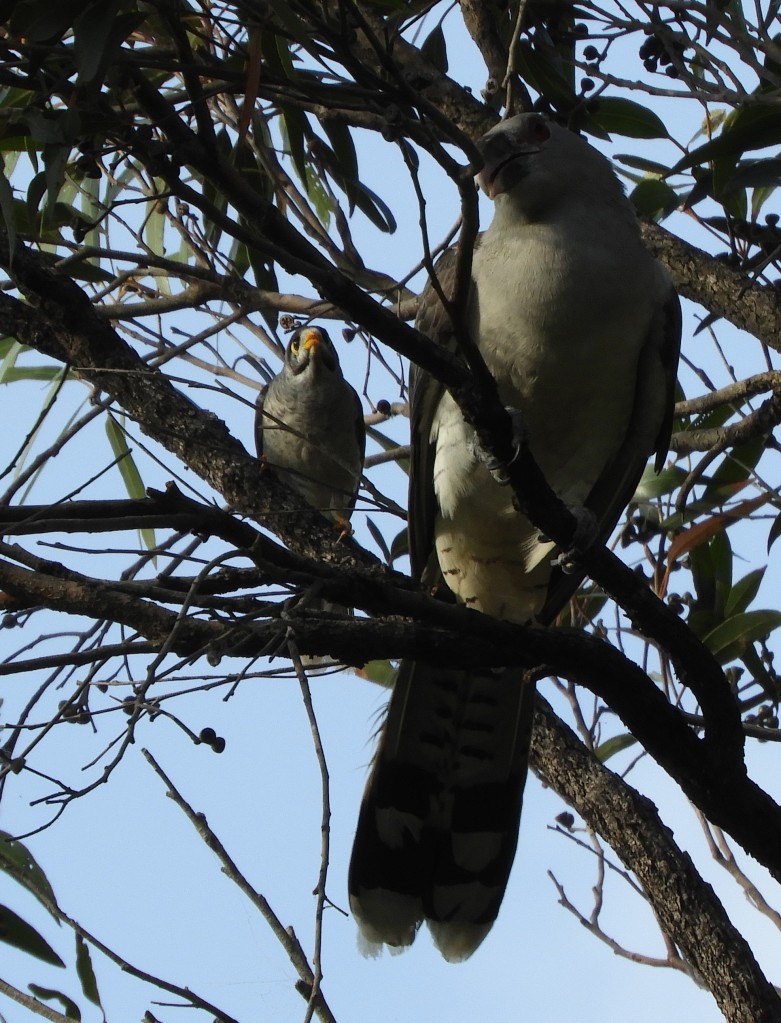
In this short video, you can hear the Noisy Miners peeping incessantly. The cuckoo emits a loud, harsh caw and cedes ground:
Next, the local Currawongs join the attack. The musical, bell-like tones are the Currawongs. The cuckoo flinches and utters its harsh croak. Then I noticed that there’s a Currawong nest just below where the cuckoo is sitting!
Like most cuckoos, Channel-billed Cuckoos are parasitic. They don’t build nests of their own. Instead, they look for a likely host (a Currawong does very nicely, thank you) and lay an egg in the chosen host’s nest. The Currawongs take over all parental duties, looking after the egg along with those of their own, then feeding the baby bird.
Channel-billed Cuckoo chicks don’t turf the other chicks out of the nest (many types of cuckoo chicks do) but they do eat a lot, and grow significantly bigger than the Currawong chicks.
Having decided that the neighbourhood is reasonably quiet and safe for a bit, the cuckoo eyes the nest and starts its approach:
Quick as a flash, it hops up into the nest and lays its egg:
Below is a still picture of the Currawong’s nest. I’ll keep an eye on it, in case I can spot the Currawong and cuckoo chicks when they arrive:

Channel-billed Cuckoo | Scythrops novaehollandiae | Approximate length: 58-65 cm
Noisy Miner, also called Australian Miner | Manorina melanocephala | Approximate length: 26 cm
Pied Currawong | Strepera graculina | Approximate length: 45 cm
Date spotted: 10 October 2021 (spring)
Location: Allambie Heights, New South Wales, Australia
Currawong snacks on brush-turkey’s scrapings
Spring is approaching, and male Australian Brush-turkeys are busily preparing their mounds in the hopes of attracting a female. This year there seem to be more brush-turkeys in my area than ever before. On the plus side, they do a great job of clearing the ground near their chosen location for a mound. On the minus side, the mound itself is a little unsightly. Unless you happen to be a brush-turkey, of course.
A canny currawong hung around close to this particular busy brush-turkey, snapping up the beetles and grubs that the brush-turkey’s scraping exposed:
The brush-turkey was scraping the leaves methodically and energetically in a single direction. His destination lay behind him. So I went round and found the large pile that he was creating. It was already over a metre high and three to four metres across.
A day later, I returned to the area and found the brush-turkey close to his mound:

Common name: Australian Brush-turkey
Scientific name: Alectura lathami
Approximate length: 60-70 cm
Date spotted: 25 August 2021 (winter)
Location: Manly Dam Park, New South Wales, Australia: 33°46’37.7″S 151°14’48.8″E
Noisy currawongs enjoying blueberry ash berries
Currawongs are intelligent, curious, and noisy birds. The Australian dawn and dusk ring with their calls. Yesterday I was walking along a bush path when I heard a tremendous ruckus up ahead in the treetops. Currawongs whistling and whooping, branches swishing, and twigs clattering to the ground.
“Uh-oh,” thought I. “What have they found? Some possum caught in the harsh light of the day, or a bird of prey that dared to venture into currawong territory?”
The sound was all round me. At first it was difficult to find a single bird to focus the camera on:
Drawing closer, I saw the source of all the fuss. The blueberry ash trees are fruiting. Here’s a closeup of the berries from one of the trees that the currawongs were feasting on. The berries are small, and a pretty blue in colour. If you look closely, you can see the characteristic tiny yellow spots on the berries:
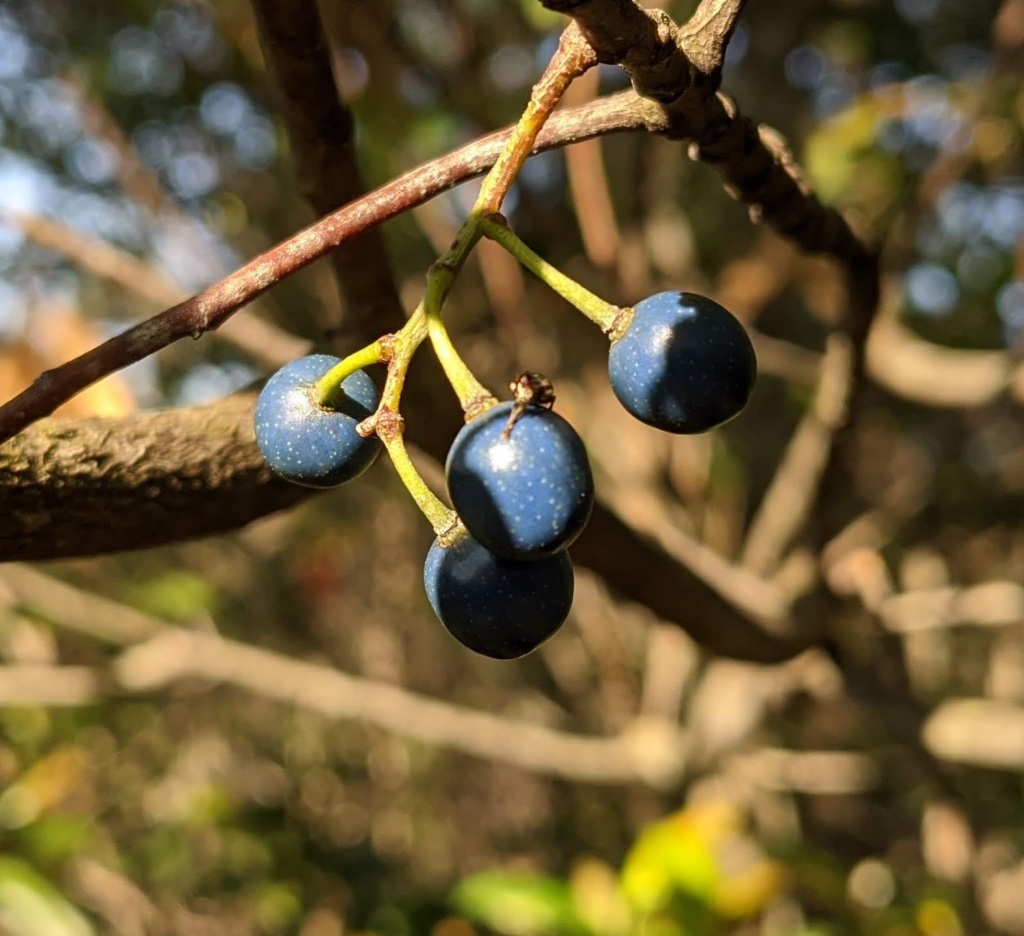
It seems these berries are irresistible to a currawong. What’s more, from all the commotion, you’d think there weren’t enough berries to go round! In the next video, I managed to catch some pictures of the currawongs themselves. At times you can hear a butcher bird interjecting too:
Here’s a cheeky glare from one of the critters making all the noise:

Common name: Pied Currawong
Scientific name: Strepera graculina
Approximate length: 45 cm
Date spotted: 3 October 2020 (spring)
Location: Manly Dam Park, New South Wales, Australia: 33°46’28.2″S 151°14’58.4″E
Currawong in song
Currawongs are medium-sized birds that look similar to magpies and butcher birds. An easy way to tell them apart is that currawongs don’t have white markings on their heads, where magpies and butcher birds do have white collars or caps. Currawongs have yellow eyes, where magpies’ eyes are red.
The song of the currawong is varied, with clear bell-like sounds, whistles, and yodels. This video shows a currawong listening to the song of others around him, and responding every now and then.
Common name: Pied Currawong
Scientific name: Strepera graculina
Approximate length: 45 cm
Date spotted: 16 October 2016
Season: Summer
Location: Manly Dam National Park, New South Wales, Australia
Approximate latitude/longitude: 33°46’42.1″S 151°14’59.3″E








